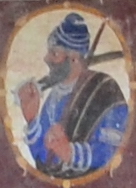It is proposed that this article be deleted because of the following concern:
If you can address this concern by improving, copyediting, sourcing, renaming, or merging the page, please edit this page and do so. You may remove this message if you improve the article or otherwise object to deletion for any reason. Although not required, you are encouraged to explain why you object to the deletion, either in your edit summary or on the talk page. If this template is removed, do not replace it . The article may be deleted if this message remains in place for seven days, i.e., after 17:52, 5 April 2025 (UTC). Find sources: "Battle of Sarai Nurdin" – news · newspapers · books · scholar · JSTOR Nominator: Please consider notifying the author/project: {{ subst:proposed deletion notify |Battle of Sarai Nurdin|concern=Despite the claim in the lead, this is a non-notable battle; the main source given is primary. Not to mention that this is not a battle, and "Battle of Sarai Nurdin" specifically is invented: [https://scholar.google.com/scholar?hl=en&as_sdt=0%2C5&q=Battle+of+Sarai+Nurdin&btnG=].}} ~~~~ |
| Battle of Sarai Nurdin | |||||||
|---|---|---|---|---|---|---|---|
| Part of Mughal-Sikh Wars | |||||||
| |||||||
| Belligerents | |||||||
| | | ||||||
| Commanders and leaders | |||||||
| | | ||||||
| Strength | |||||||
| 2 [1] | 100 [2] cavalry | ||||||
| Casualties and losses | |||||||
| 2 | 100 and jalal ul din | ||||||
The Battle of Sarai Nurdin was fought between the Khalsa's 2 Sikhs Bhai Bota and Bhai Garja Singh and the Mughal forces led by Subahdar (Governor) Zakariya Khan. This battle is one of the most important battles in Sikh history, and is one of the most significant battles after Banda Singh Bahadur's execution.
